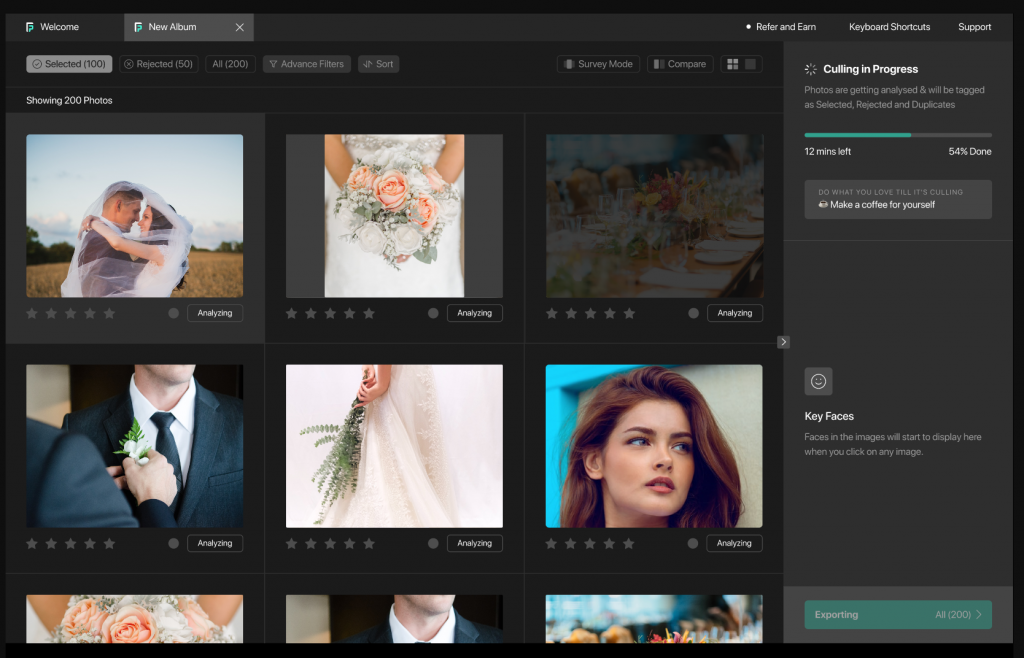Countless studies have proven how emotions influence our choices. How we feel at certain moments in our day-to-day lives influence, alter, or even directly dictate the outcome of any situation. In dealing with an emotion-inducing art form such as photography, this fact remains true.
As a professional photographer, you are constantly faced with thousands of images that need to be sorted and filtered. What makes the cut and what doesn’t relies solely on your final call. Despite conscious efforts in making objective decisions, there will always be a lingering human prejudice that affects the final outcome.
What prompts us to keep some photos while discarding others?
The answer to this question delves into the realm of psychology where emotions play a pivotal role in the photo culling process.
How Emotions Influence Your Choices in Photo Culling
First off, it’s important to establish that photo culling is considered as one of the most crucial skills any good photographer needs to possess. And for good reason. Culling is the process of filtering through image sets and curating the best ones that meet a specific criteria. The primary goal of this phase is to identify and retain the highest quality images while discarding the rest.

In essence, photo culling requires objectivity and consistency in order to deliver the best results. However, when done manually, the sorting process becomes highly subjective. The variability in your final selection can be glaring. Because manual photo culling primarily relies on your personal judgment at the time of the selection process, the physical, mental, and even emotional factors affecting your decisions lead to this inconsistency.
Whether you’re doing it yourself or have someone else to cull images, there’s no guarantee that you will achieve the results that you want for a specific photo set. Another person culling your photos may not have the same criteria, style, and preferences that you apply. Likewise, your personal point of view may change as you sort through thousands of photos.
This subjectivity makes it even more challenging to maintain a consistent style or quality across your portfolio. As a result, it leads to higher risks of mistakenly discarding potentially valuable shots. In a rush to sort images quickly, it’s easy to overlook photos that may only require minor edits to transform into remarkable images.
Whether it’s for the purpose of freeing up storage space on your devices, curating a gallery for social media, updating your portfolio, or preparing for editing, the process of culling images always puts you in the position of evaluating and making decisions about each photo.
This is where individualities and personal judgments are drawn upon.
The Psychological Dynamics of Photo Culling
Let’s face it: photo culling is far from a straightforward, rational process. Emotions are intrinsically intertwined with decisions, which leads to a complex set of psychological dynamics that impact your final choices.
As a photographer, you may have a particular favorite shoot. One that won you awards from, one of your loved ones, or one that brought you an entirely unique experience. Whatever it may be, there’s always a tendency to gravitate toward images you consider special. As such, photo culling becomes even more time-consuming, exhausting, frustrating, and delivers inconsistent results.
In order to address this better, it’s important to become aware of the key psychological aspects that show how emotions can influence your choices.
Emotional Attachment
Our emotional attachment to people, places, and events depicted in photos is a significant influencer when deciding which photos to keep. Photographers often find it challenging to discard images associated with significant life moments, even if they are of subpar quality or visually unremarkable. The sentimentality attached to these photos can make it difficult to part with them, resulting in a larger digital clutter.
Understanding your emotional attachment to certain photos can help you make more objective decisions. Create a checklist of technical criteria that you will need to consider for each photo to make the cut. This may include duplicates, focus, composition, and exposure, to name a few. You might find it easier to justify letting go of identical shots or misaligned photos. This way, you can keep the ones that truly capture the essence of the moment.
Strong Sense of Nostalgia
Nostalgia can be a powerful emotion that tugs at our hearts when we revisit old photos. These images transport us back in time, evoking feelings of fondness and longing for those memorable events. Even if a particular photo doesn’t seem significant at first glance, it can trigger a rush of emotions related to the moment it captures.
While nostalgia is an inspiring emotion, it can also lead to hoarding unnecessary photos. Try to strike a balance. Keep the images that evoke the most vivid and cherished memories, while considering the overall quality and relevance of the rest.
Social Validation
In the age of social media, photo culling decisions are also influenced by the need for social validation. Photographers often keep and share photos that have the potential to garner the most likes, comments, and admiration from the online community. There’s nothing wrong about engaging audiences as it can boost your business. However, this leads to retaining photos that may not actually hold significance but are perceived as more popular.
Although social validation is a legitimate motivator, it’s essential to remember that your image collection is primarily a reflection of your unique style and personality as a professional photographer. Prioritize photos that genuinely reflect your technical expertise, creativity, and flair, over those chosen solely for external approval.
Fear of Forgetting
One of the most common manifestations that show how emotions influence your choices is photo hoarding due to the fear of forgetting. Everyone keeps photos as a visual archive of their lives. The idea that you might one day forget the people, places, and moments depicted in these photos can be a source of anxiety. For professional photographers who get to experience some of the most historical and once-in-a-lifetime shoots, this is a real issue.
To overcome the fear of forgetting, keep a smaller, curated collection of photos that truly encapsulate your most memorable events. Organize them effectively and you’ll find that it’s easier to revisit valuable collections without being overwhelmed by sheer volume.
Decision Fatigue
The more you cull, the more exhausted you become. Sorting through hundreds or even thousands of photos can be overwhelming, leading to decision fatigue. This mental exhaustion undeniably takes a toll on your judgment and decision-making abilities. It can result in impulsive decisions to keep or delete images without thoughtful consideration of their value and image quality.
To combat decision fatigue, break the culling process into smaller, manageable sessions. Set clear criteria for what you want to keep and stick to them. This will help you make more deliberate choices and avoid unnecessary emotional stress. More efficiently, explore digital solutions such as AI-powered photo culling software. It automatically sorts and determines which images match your standards. Because AI does not elicit human emotions and their own judgments, culled photos end up more consistent in terms of style and quality. Such tools not only simplify your workflow, but also saves you from decision fatigue.
Conclusion
Photo culling is a process that touches upon psychological dynamics in profound ways. By understanding how emotions influence your choices, you can make more informed and meaningful decisions about the photos you keep and discard.
While emotions will always be an integral part of photography as an art form, a balanced approach that values authenticity and significance can help you curate a photo collection that truly reflects your unique style and experiences.
As a professional photographer, this will lead you to further growing your business, as you attract the right clients and gain the ability to streamline your photo culling process.
Ready to integrate the power of AI in your post-production process?

FilterPixel is a game-changing solution that is set to transform the way you organize and post-process your images by harnessing the power of AI. From the fundamental stages of importing and sorting photos, to the more technical areas of culling and editing, FilterPixel provides you with a smarter and easier way to go through all of these phases in producing top-quality images. Its remarkable ability to shorten the culling process by 80% and its highly customizable controls empower photographers of all levels of expertise to streamline their processes while maintaining total creative reign over their images.
Learn more about what we offer: https://filterpixel.com